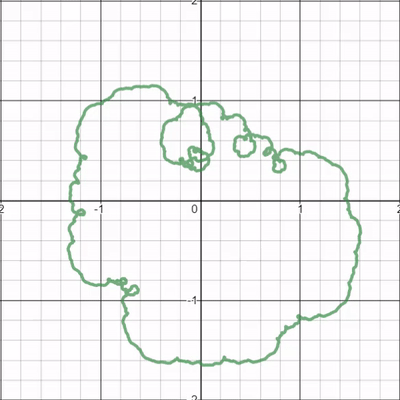What causes this fractal to curl and unwind?
Mathematics Asked on December 10, 2021
During my regular recreational late night Desmos foolery, I came across this fractal parametric equation:
$$x(t)=sum_{n=0}^infty frac{cos(2^nt+cn)}{2^n}$$
$$y(t)=sum_{n=0}^infty frac{sin(2^nt+cn)}{2^n}$$
And decided to animate $crightarrow2pi$ on a loop.
I was fascinated by the series of loops around it’s boundary that seemed to curl into existence then proceed to unwind back into thin air. If the gif doesn’t do it justice, I highly recommend checking out the link to the graph.
I’m sure this phenomenon is actually just an example of a much simpler process, but I can’t seem to wrap my head around these spiraling loops. What are your thoughts?
One Answer
This should really be a comment but it's way too long:
As the comments indicate, all we really have so far is a qualitative observation. It's quite interesting, but turning it into a precise question is nontrivial, and of course we have to do that before we can get an answer.
So let me take a stab at precisiating the phenomenon we see - or rather, precisiating one particular question about whether a general pattern we seem to observe actually holds. Specifically, I want to ask: "Do all the loops roll clockwise?"
There are a couple things we need to pay attention to:
We need a precise definition of "loop," and we then need a way to talk about the motion of a loop over time.
Whatever we whip up should be parameterization-invariant: we're really paying attention to the map $$Gamma:cmapsto{(x,y):exists t(x=sum_{n=0}^infty frac{cos(2^nt+cn)}{2^n}quadmbox{and}quad y=sum_{n=0}^infty frac{sin(2^nt+cn)}{2^n})},$$ or if you prefer "successive horizontal slices" of the surface $${(x,y,z):exists t(x=sum_{n=0}^infty frac{cos(2^nt+zn)}{2^n}quadmbox{and}quad y=sum_{n=0}^infty frac{sin(2^nt+zn)}{2^n})}subseteqmathbb{R}^3.$$
So our definition will probably use the function $$F(t,c)=(sum_{n=0}^infty frac{cos(2^nt+cn)}{2^n},sum_{n=0}^infty frac{sin(2^nt+cn)}{2^n})$$ but it will ultimately "lose information."
OK, so let's start with the notion of a loop at time $c$. There are a couple things this could mean.
From algebraic topology we have the simple notion of a continuous function $S_1rightarrowGamma(c)$ (or rather, an appropriate equivalence class of such functions). This notion is quite nice; for one thing, it produces a groupoid for each $c$, and so overall a "continuously varying groupoid."
However, that's a bit abstract; more importantly, it ignores details like direction of movement, which we definitely care about here. So while it's a very natural thing to look at, I'm not sure it's quite the right idea here.
Instead, I want to go a bit more concrete:
A loop at time $c$ is just a pair of numbers $a<b$ such that $F(a,c)=F(b,c)$ but for each $zin (a,b)$ we have $F(z,c)not=F(a,c)$. (Note that this does refer to the parameterization; that will go away later, however. The key feature here is that the parameterization $F$ is "locally injective in $c$," that is for each $t,c$ there is some $epsilon>0$ such that $Fupharpoonright (t-epsilon, t+epsilon)times{c}$ is injective.)
To talk about the motion of a loop over time, we'll introduce the notion of a bubble. Basically, a bubble is a "continuously varying nontrivial loop" which is maximal in the sense that if we could keep going either forward or backward in $c$ we do so. More precisely, we'll say that a prebubble consists of a tuple $(I,f,g)$ where $I$ is an open interval (which is allowed to extend infinitely in one or both directions) and $f,g$ are injective functions defined on $I$ such that $langle f(c),g(c)rangle$ is a loop for all $cin I$. A prebubble doesn't necessarily "tell the whole story" of a loop's lifetime, and so we further define a bubble to be a prebubble $(I,f,g)$ such that there is no other prebubble $(hat{I},hat{f},hat{g})$ with $Isubsetneq I'$ and $hat{f}upharpoonright I=f, hat{g}upharpoonright I=g$.
Now suppose I have a bubble $beta:=(I,f,g)$. At each time $cin I$ there is a "special point" in this bubble, $p_beta(c)=F(f(c),c)=F(g(c),c)$. And via some polar coordinate tedium the following question can be phrased precisely:
If $beta=(I,f,g)$ is a bubble, need $p_beta(c)$ always be moving clockwise as $c$ increases?
(The tedium is basically that the argument of a point is many-valued. It's easily dealt with, though.)
Note that as desired, at this point everything is parameterization-free - the above works as long as we fix any parameterization which is locally injective in $c$.
Now that we have a precise question, I'm sure finding the answer will be basically trivial so I'll leave that as an exercise to the reader. :P
Answered by Noah Schweber on December 10, 2021
Add your own answers!
Ask a Question
Get help from others!
Recent Answers
- Jon Church on Why fry rice before boiling?
- Joshua Engel on Why fry rice before boiling?
- haakon.io on Why fry rice before boiling?
- Peter Machado on Why fry rice before boiling?
- Lex on Does Google Analytics track 404 page responses as valid page views?
Recent Questions
- How can I transform graph image into a tikzpicture LaTeX code?
- How Do I Get The Ifruit App Off Of Gta 5 / Grand Theft Auto 5
- Iv’e designed a space elevator using a series of lasers. do you know anybody i could submit the designs too that could manufacture the concept and put it to use
- Need help finding a book. Female OP protagonist, magic
- Why is the WWF pending games (“Your turn”) area replaced w/ a column of “Bonus & Reward”gift boxes?
